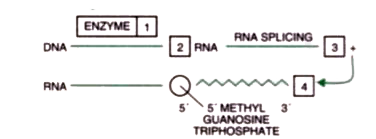Additional sequences of transcription unit
Regulator
Promotor
Terminator
Exons
The correct Answer is:A
To answer the question regarding the additional sequences of a transcription unit, we will break down the concept of a transcription unit and identify the components involved.
1. Understanding Transcription:
- Transcription is the process where genetic information from DNA is copied to RNA. This is a crucial step in gene expression.
2. Identifying the Components of a Transcription Unit:
- A transcription unit typically consists of three main regions:
- Promoter: This is the region where RNA polymerase binds to initiate transcription.
- Structural Gene: This region contains the actual coding sequences that will be transcribed into RNA.
- Terminator: This sequence signals the end of transcription.
3. Considering Additional Sequences:
- The question asks for additional sequences associated with the transcription unit. These sequences can include regulatory elements that influence the transcription process.
4. Evaluating the Options:
- Option A: Regulator: This refers to additional sequences that can enhance or inhibit the transcription of the gene. They are not part of the core transcription unit but play a significant role in regulating gene expression.
- Option B: Promoter: This is a core component of the transcription unit, not an additional sequence.
- Option C: Terminator: Like the promoter, this is also a core component of the transcription unit.
- Option D: Exon: Exons are parts of the structural gene that are expressed, and they are also not considered additional sequences.
5. Conclusion:
- The additional sequence of the transcription unit is the Regulator (Option A), as it is involved in the regulation of transcription but is not part of the basic structure of the transcription unit itself.
Final Answer:
The additional sequence of the transcription unit is Option A: Regulator.
---
- Transcription is the process where genetic information from DNA is copied to RNA. This is a crucial step in gene expression.
- A transcription unit typically consists of three main regions:
- Promoter: This is the region where RNA polymerase binds to initiate transcription.
- Structural Gene: This region contains the actual coding sequences that will be transcribed into RNA.
- Terminator: This sequence signals the end of transcription.
- The question asks for additional sequences associated with the transcription unit. These sequences can include regulatory elements that influence the transcription process.
- Option A: Regulator: This refers to additional sequences that can enhance or inhibit the transcription of the gene. They are not part of the core transcription unit but play a significant role in regulating gene expression.
- Option B: Promoter: This is a core component of the transcription unit, not an additional sequence.
- Option C: Terminator: Like the promoter, this is also a core component of the transcription unit.
- Option D: Exon: Exons are parts of the structural gene that are expressed, and they are also not considered additional sequences.
- The additional sequence of the transcription unit is the Regulator (Option A), as it is involved in the regulation of transcription but is not part of the basic structure of the transcription unit itself.
The additional sequence of the transcription unit is Option A: Regulator.
Topper's Solved these Questions
- MOLECULAR BASIS OF INHERITANCEBOOK - AAKASH SERIESCHAPTER - MOLECULAR BASIS OF INHERITANCEEXERCISE - Exercise-I (Genetic Code)
23 Videos
- MOLECULAR BASIS OF INHERITANCEBOOK - AAKASH SERIESCHAPTER - MOLECULAR BASIS OF INHERITANCEEXERCISE - Exercise-I (Translation, Gene expression and regulation)
34 Videos
- MOLECULAR BASIS OF INHERITANCEBOOK - AAKASH SERIESCHAPTER - MOLECULAR BASIS OF INHERITANCEEXERCISE - Exercise-I (DNA Replication)
16 Videos
- MINERAL NUTRITIONBOOK - AAKASH SERIESCHAPTER - MINERAL NUTRITIONEXERCISE - Exercise - III
52 Videos
- NEURAL CONTROL AND COORDINATIONBOOK - AAKASH SERIESCHAPTER - NEURAL CONTROL AND COORDINATIONEXERCISE - EXERCISE-III( PREVIOUS AIPMT / NEET QUESTIONS)
33 Videos
Similar Questions
In transcription
View SolutionIn a transcription unit
View SolutionDefine transcription unit
View SolutionRecognition sequence for transcription in prokaryotes is
(a) TATATAT
(b) TATAAT
(c) TATAAAT
(d) CAAT
View SolutionMain enzyme of transcription-
View SolutionDraw a labelled schematic structure of a transcription unit. Explain the function of each component of the unit in the process of transcription unit. Explain the function of each component of the unit in the process of transcription .
View SolutionDraw a labelled schematic structure of a transcription unit. Explain the function of each component of the unit in the process of transcription unit.
View SolutionDraw a labelled schematic structure of a transcription unit. Explain the function of each component of the unit in the process of transcription unit.
View SolutionGiven below is a sequence of steps of transcription in a eukaryotic cell. Fill up the blanks (1, 2, 3, 4) left in the sequence.

View SolutionGiven below is a sequence of steps of transcription in a eukaryotic cell. Fill up the blanks (1,2,3,4) left in the sequence .

View Solution
